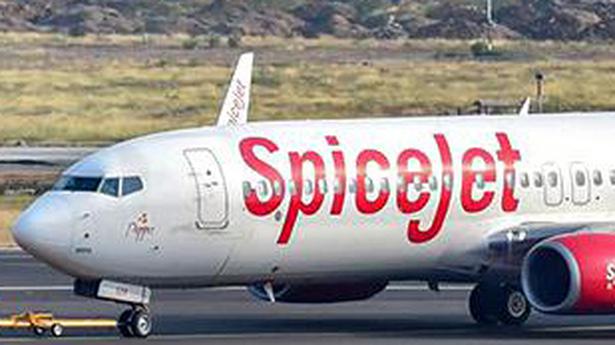What are the factors that might have caused the flight to experience severe turbulence? What about adverse weather?
What are the factors that might have caused the flight to experience severe turbulence? What about adverse weather?
The story so far: On the evening of May 1, a Boeing 737-800 aircraft of low-cost private carrier SpiceJet, on a scheduled flight (SG-945) operating from Mumbai to Andal (Durgapur, West Bengal) with 195 passengers on board (189 passengers and six crew), experienced severe turbulence, at around 16,000 feet, while on approach to the destination airport.
What happened on the flight?
Due to severe turbulence, nearly 17 passengers suffered head, shoulder, spinal, forehead and facial injuries that were serious enough to warrant hospitalisation. The aircraft too experienced damage in the cabin. Visuals showed oxygen mask compartments open, sections of the cabin ceiling having come apart exposing ducts, damage to some seat handrests and the cabin being in a state of disarray, with items from the galley as well as passenger belongings strewn around. The flight crew took manual control of the aircraft (from autopilot mode) and the aircraft made a safe landing about 20 minutes later.
A preliminary report by India’s civil aviation regulatory body, the Directorate General of Civil Aviation (DGCA), categorised it as an “accident”. It said: “… the vertical load factor [which is related to aviation] varied from 2.64G and minus 1.36G, and during this period, the autopilot got disengaged for two minutes….” In addition, there were speed variations. The crew have been off rostered. The airline’s aircraft maintenance engineer who released the aircraft from Durgapur (the plane was flown from Andal to Kolkata later) has also been derostered. The aircraft has been grounded and the DGCA has ordered a full inspection of the SpiceJet aircraft fleet.
Why has it been called an ‘accident’?
The occurrence would fall under one of the conditions that defines an “accident” in aviation, i.e., “an occurrence associated with the operation of aircraft which … i) in the case of a manned aircraft, takes place between the time any person boards the aircraft until such time as all such persons have disembarked…. a) a person is fatally injured or seriously injured as a result of: i) being in the aircraft ii) direct contact with any part of the aircraft including parts of which have become detached from the aircraft….”
India’s Aircraft Accident Investigation Bureau (AAIB), has taken over investigation into the occurrence. The AAIB is responsible for “classification of safety occurrences” that involve aircraft operating in Indian airspace falling under the categories ‘accidents’, ‘serious incidents’ and ‘incidents’. The AAIB says it investigates any ‘accident’ and ‘serious incident’ involving aircraft having what is called an ‘all up weight (AUW) of more than 2,250 kg’.
Was there awareness of turbulence? What could have happened?
A pilot says air turbulence can be graded as light, moderate, severe and extreme. In the last classification, there may be even structural damage and possible loss of aircraft control. In terms of the categorisation of turbulence, there is (in general): convective turbulence (or turbulence linked to cloud convection); mechanical turbulence (low-level turbulence); orographic turbulence (linked to elevated terrain such as mountains); clear air turbulence; low-level jet streams, and also wake turbulence caused by other aircraft.
In a tweet, Madhavan Rajeevan, former Secretary, Ministry of Earth Sciences, who has “research interests on monsoons” has said: “In my understanding Spice jet has their own weather forecasting team for their planning. They don’t take [the] services of [the] IMD [India Meteorological Department]. All airlines should take weather services very seriously for their operations….”
It must be reiterated, however, that airlines do invest considerable resources in the training of crew in aviation meteorology.
Captain A. (Mohan) Ranganathan, a former airline instructor pilot and aviation safety adviser, who shared resource material with The Hindu from an ‘Adverse Weather Operations training kit’ prepared on behalf of the DGCA in 2001, said that from initial analysis, it appeared that the flight crew had not followed the speed for turbulence penetration. This, he said, was probably why severe conditions were encountered. The aviation expert highlighted the important factor of Total Air Temperature (TAT), which is the best guide for turbulence. TAT monitoring by crew is essential while in flight, more so during the crucial phases of aircraft climb and descent, he said. A key point highlighted in the training kit was for a pilot to be alert to a temperature inversion between 16,000 feet and 24,000 feet as being an indicator of adverse weather conditions. He said that aviation awareness about TAT is low these days.
More importantly, the aviation expert drew attention to a weather phenomenon (and an aviation hazard) called the Norwester over eastern and northeastern India which occurs in March, with its frequency increasing in May and early June (almost eight occurrences a month). This subject is in focus as the flight path of the SpiceJet aircraft was over Maharashtra, Chhattisgarh and Jharkhand, with its descent into West Bengal.
Norwesters are destructive squalls which take place in the afternoon/evening; what is more, cells of weakening down drafts regenerate themselves as new storm cells. An aircraft can experience a stall and loss of lift when flying near or through them. There is also an additional high risk of hail damage. The professional aviation advice is to avoid making an approach if in the vicinity of a Norwester. Captain Ranganathan also gave the example of the kind of turbulence that can be expected, when in the 1980s, a Boeing 737 on the Agartala-Calcutta sector got into one such cell and was buffeted so severely that it caused several rivets on the aircraft fuselage to go missing; this was discovered after landing.
In a typical Norwester, if flying in proximity of what is called its downwind wake area (these can be generated given the way a Norwester is formed), an aircraft can get sucked into the centre of the storm cell and experience damage and severe turbulence.
A senior commander who flies Airbus aircraft said turbulence detection, in general, would also depend on whether it was clear air turbulence or, separately, what is called avoidable weather. If it was weather that was visibly noticeable, or read on the aircraft’s weather radar, the question during the investigation would be whether the crew were monitoring this and had situational awareness. While the weather radar system fitted in the new generation of aircraft is technologically advanced — some models can perform 3D picturisation using multibeams for hundreds of kilometres ahead and autoscan from the ground up to 60,000 feet — management of adverse weather flying calls for good meteorological knowledge, a thorough understanding of the aircraft’s radar functions, planning, anticipation, and, most importantly, the crew’s overall assessment of the weather situation.
THE GIST
On May 1, a Boeing 737-800 aircraft of SpiceJet, on a scheduled flight with 195 passengers on board experienced severe turbulence which resulted in injuries to passengers and damage to the aircraft. The Directorate General of Civil Aviation (DGCA), has categorised it as an “accident”.
An aviation expert stated that it looked like the flight crew had not followed the speed for turbulence penetration. This, he said, was probably why severe conditions were encountered. The aviation expert highlighted the important factor of Total Air Temperature (TAT), which is the best guide for turbulence, and how awareness about the same is low these days.
Flying in adverse weather calls for good meteorological knowledge, a thorough understanding of the aircraft’s radar functions, planning, anticipation, and, most importantly, the crew’s overall assessment of the weather situation.




